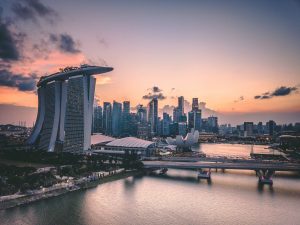Singapore is preparing its defenses for war, but not for a military conflict.
“These are life and death matters,” proclaimed Prime Minister Lee Hsien Loong in August 2019 during his annual National Day Rally speech. Climate threats, he said, should be treated with “utmost seriousness” and “like we treat the Singapore Armed Forces.” Such alarm comes due to Singapore’s geography; as the country is especially vulnerable to rising sea levels, it faces an immediate threat posed by climate change.
Prime Minister Lee’s pleas were echoed again during his speech at the UN secretary-general’s Climate Action Summit in September 2019, in which he called upon world leaders to take “responsibility” and “to safeguard our future, and the futures of our children and grandchildren.” Armed with government foresight and initiative, Singapore is preparing its defenses to combat the threat of rising sea-levels.
These preparations come as sea levels are projected to rise according to Singapore’s Climate Action Plan “between 0.25 m and 0.76 m towards the end of the century.” Much of the country’s landmass is only 15 m above the mean sea level and about 30 percent of the country less than 5 m above mean sea level. The country is particularly vulnerable to rising sea levels because of the gravitational-attraction impact exerted by melting ice sheets. Around Singapore, the rate of increase of the mean sea level was almost double than the global sea level between 1993 and 2009. During this period, the mean sea level per year around Singapore was up to 4.6 millimeters compared to the global level per year of 2.8 millimeters.
Combating rising sea levels will lead to large economic costs for Singapore. Constructing and maintaining seawalls and other coastal infrastructure is expected to rise in cost from the current levels of “3 million to 6 million by 2050 and 17 million annually by 2100.” The country has already taken measures such as investing $1 billion to improve the country’s drainage system between 2012 and 2018. These measures, among many others, are an attempt to curtail loss of land value from flooding, which is “estimated to be 2 billion” by the year 2100.
The coastline marks the frontline in efforts to ward off potential catastrophe and infrastructure damage. Currently, the coast is being protected from erosion through the construction of walls and stone embankments which cover almost 80 percent of Singapore’s coastline. The usage of natural barriers are being researched as well as the use of plants like seagrasses and mangroves to work as natural barriers to potential flooding.
Climate change also poses a threat to Singapore’s water supply. Water resource management is crucial to future sustainability as the nation has a very limited water supply. The nation’s drainage systems are at risk with increased rainfall intensity as well as the reliability of the water supply is at risk from dry weather. These risks drive Singapore to seek resilient water resources that are not dependent on rainfall such as NEWater and desalinated water. It is predicted that NEWater and desalinated water will make up around 70 percent of Singapore’s water resources by 2030 and around 80 percent by 2060.
Keeping potential floodwater itself at bay is critical to avoid this threat to the water supply. Rainfall events could increase in frequency and intensity due to climate change and the national water agency has taken initiatives to institute versatility to the nation’s drainage system. Through expanding and deepening drains and canals, on-site detention of stormwater runoff, and implementation of crest protection and flood barrier, the “Source-Pathway-Receptor” approach ensures that stormwater management addresses all parts of the drainage system. Developers of new sites are being required to implement various on-site measures to ensure the flow of stormwater into the public drainage system mitigates through installation of detention tanks, rain gardens, green roofs, and retention ponds.
While angst and anticipation for climate change induced sea-level rise looms over the country, Singapore can present itself as a model for concentrated efforts to thwart the effects of climate change in Asia. Singapore already attracts global water companies as a “global hydrohub,” which has led to collaborations between the Singapore Delft Water Alliance and SeCURE131, a partnership between Singapore and the Netherlands, both countries with areas of land near sea level, that focuses on climate change, natural disasters, and sustainable water management. As Prime Minister Lee proclaims on the world stage, as the visible effects of climate change draw nearer and evident, such as in Singapore, global priorities must shift to be aggressively combative towards climate change.
Adam Kiedrowski is an independent writer, researcher, and political analyst.
































